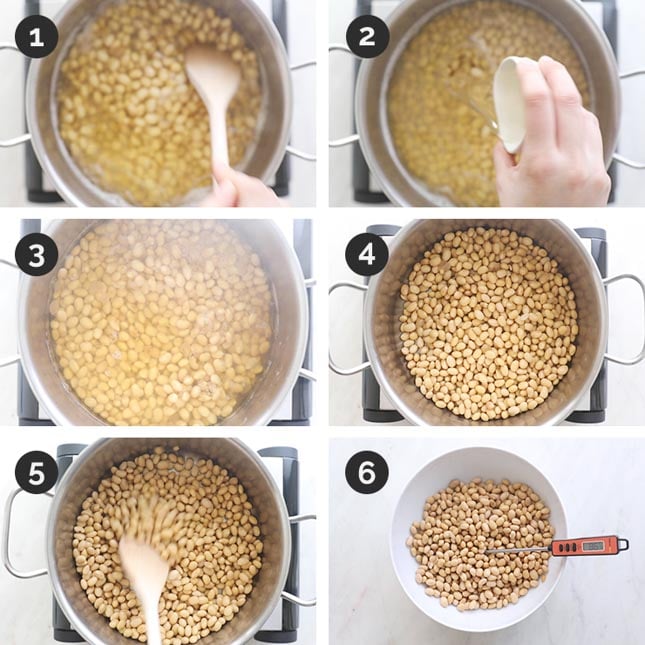Tempeh is an excellent source of good quality vegan protein. It's tasty, satiating, nutritious and to make it you only need 3 ingredients.

Tempeh is the perfect meat alternative. It's healthy and a very good source of vegan protein, and it doesn't contain any additives or preservatives. It has a peculiar flavor, but it's very tasty and satiating, as well as easy to make.
Although making tempeh at home requires some cooking time, you just need to follow some easy steps to prepare it. Once it's ready, there's plenty of ways to cook it and it works perfectly to incorporate some protein to your favorite dishes.
On the other hand, tempeh is very versatile and it's usually made with soy, but if you don't consume it you can also make it with other legumes like chickpeas or lentils. Feel free to add some spices or marinate it as well, or just customize it however you'd like.
Tempeh, a great way of eating plant-based protein. It's healthy and to make it you only need 3 ingredients and quite some time, but you can prepare it ahead of time and freeze it. It's the perfect meat substitute!
How to make tempeh - Step by step

- Soak the soybeans in water overnight (for 12 hours or longer). Drain and rinse.
- Boil the soybeans in water over medium-high heat for 20 minutes (photo 1).
- Add the vinegar (photo 2), stir, and cook for 10 to 40 more minutes until the soybeans are soft (photo 3).
- Drain the soybeans and place them back to the pot (photo 4). Cook over medium heat, stirring frequently until all the liquid has evaporated (photo 5).
- Allow the soybeans to cool to about 95ºF or 35ºC. I always use an instant-read thermometer (photo 6).

- Add the tempeh starter (photo 7), stir until well combined, and set aside (photo 8).
- For the next step, use a plastic zip-lock bag or a banana leaf. If you’re going to use a zip lock bag, perforate the bag first at one-inch interval all over (photo 9). I used two of them.
- Then divide the soybeans between the two bags (photo 10), seal them, and flatten out the soybeans evenly (photo 11).
- To incubate the tempeh, you can use a dehydrator, an incubator, or your oven. If you use a dehydrator or an incubator, place the bags inside and leave them at a temperature between 85°F and 90°F (30-35ºC) for the next 24 to 48 hours.
- If you use the oven, transfer the two plastic bags to your oven with only the lights on for 12 hours (photo 12). Then remove from the oven and keep in a warm place for up to 48 hours.
- After 12-24 hours you should start to see some white mycelium growing on the soybeans. The tempeh is ready when the entire surface is covered with dense, white mycelium (some black or gray spots are fine), as well as the spaces between the beans.
- Once the tempeh is ready, let the bags cool at room temperature and transfer the tempeh to an airtight container.
Pro tips
- If you don't want to use plastic, feel free to make tempeh the traditional way using a banana leaf. You will find them at some Asian supermarkets and you can close them with toothpicks.
- Another option is to use a glass container with a plastic cover. I've seen recipes using both methods, although I've never tried them myself.
- Any type of vinegar will work, although my favorite ones are rice vinegar and apple cider vinegar.
- I bought the tempeh starter online.
- Feel free to use other legumes like chickpeas or lentils if you don't consume soy.

What is tempeh?
Tempeh is a meat substitute made with legumes, usually soybeans. It's very high in good-quality vegan protein, so it's nutritious, filling, and very versatile.
Its firm texture makes it perfect to use in plenty of different recipes, so it really is an amazing ingredient to have on hand!
How long does tempeh keep?
Tempeh is the perfect meat substitute, as it's very versatile. You can prepare plenty of different recipes with it and it also has a very nice texture. If you have lots of leftovers, keep them in the fridge in an airtight container for up to 1 week.
Can I freeze tempeh?
Yes, you can. Just let it cool, transfer it into a zip-lock bag or an airtight container, and keep it in the freezer for up to 3 months. To thaw, transfer it into the fridge overnight or steam it if you don't have much time. After that, you can cook it normally.
How to serve tempeh
Tempeh needs to be cooked properly before eating it. I recommend you boil it first so it softens a little. After that, you can fry it, bake it, sautée it... And of course, you can add it to your favorite dishes.
Eat it with cauliflower steaks or sauteed kale to incorporate some protein to these meals or add it to your vegan burritos or vegan tacos. You can also serve it with some sauteed veggies or even vegetable tempura.
Looking for more meat substitute recipes?

Did you make this tempeh recipe?
Please leave a comment below, share it or rate it. You can also FOLLOW ME on FACEBOOK, INSTAGRAM, and PINTEREST. I’d love to see what you cook!
📖 Recipe

Tempeh
Ingredients
- 2 cups dried soybeans
- 3 tablespoon vinegar, I used rice vinegar
- ¾ teaspoon tempeh starter, rhizopus mold
Instructions
- Soak the soybeans in water overnight (ideally 12 hours or longer).
- Drain and rinse.
- Add the soybeans to a large pot with boiling water and cook over medium-high heat for 20 minutes.
- Add the vinegar, stir and cook for 10 to 40 more minutes or until the soybeans are soft, but not mushy. Soybeans may take from 30 to 60 minutes to cook in total.
- Drain the soybeans and place them back to the pot. Cook over medium heat, stirring frequently until all the liquid has evaporated.
- Allow the soybeans to cool to about 95ºF or 35ºC. I always use an instant-read thermometer, but that's up to you.
- Add the tempeh starter, stir until well combined, and set aside.
- For the next step, you can use a plastic zip-lock bag, which is pretty convenient for this recipe or make it the traditional way by using a banana leaf. I’ve always used a plastic bag and I use it multiple times.
- If you use a zip-lock bag, perforate the bag first at one-inch interval all over. I used a wooden stick and two plastic bags.
- Then divide the soybeans between the two bags, seal them and flatten out the soybeans evenly.
- To incubate the tempeh, you can use a dehydrator, an incubator, or your oven. I prefer to use a dehydrator myself, but the oven also works really well. If you’re going to use a dehydrator or an incubator, place the bags inside at a temperature between 85°F and 90°F (30-35ºC) for the next 24 to 48 hours.
- If you’re going to use the oven, transfer the two plastic bags to your oven with only the lights on for 12 hours. Then remove from the oven and keep them in a warm place for up to 48 hours.
- After 12-24 hours you should start to see some white mycelium growing on the soybeans. The tempeh is ready when the entire surface is covered with dense, white mycelium (some black or gray spots are fine), as well as the spaces between the beans.
- Once the tempeh is ready, remove the bags from the dehydrator, incubator or oven and let the tempeh cool at room temperature. Then transfer it to an airtight container.
- Keep it in the fridge for up to 1 week or in the freezer for up to 3 months.
Notes
- If you don't want to use plastic, feel free to make tempeh the traditional way using a banana leaf. You will find them at some Asian supermarkets and you can close them with toothpicks.
- Another option is using a glass container with a plastic cover. I've seen recipes using both methods, although I've never tried them myself.
- Any type of vinegar will work, although my favorite ones are rice vinegar and apple cider vinegar.
- I bought the tempeh starter online.
- Feel free to use other legumes like chickpeas or lentils if you don't consume soy.
- Eat the tempeh with cauliflower steaks or sauteed kale to incorporate some protein to these meals or add it to your vegan burritos or vegan tacos. You can also serve it with some sauteed veggies or even vegetable tempura







Valerie says
You don't mention dehulling the soybeans. Are you having success without removing the hulls? That is the most time consuming part for me, and I'd love to bypass that step. Re: incubation, I use a pet heating pad (lowest setting is 80 deg.) and then place a small inverted box over it.
Iosune Robles says
Hi Valerie! It is not necessary 🙂
Bruce Pitcairn says
I am curious after reading your recipe. Where will I find a food dehydrator that will go as low as 85-90 degrees F (30-35 C)? The lowest temperature I have seen on a food dehydrator is 95 degrees F. The most expensive one sold on Amazon has the lowest temperature of 95 degrees F.
Thank you.
Iosune Robles says
Hi Bruce! I have found plenty of them on the Internet! For example this one: Excalibur 3948cdb 🙂